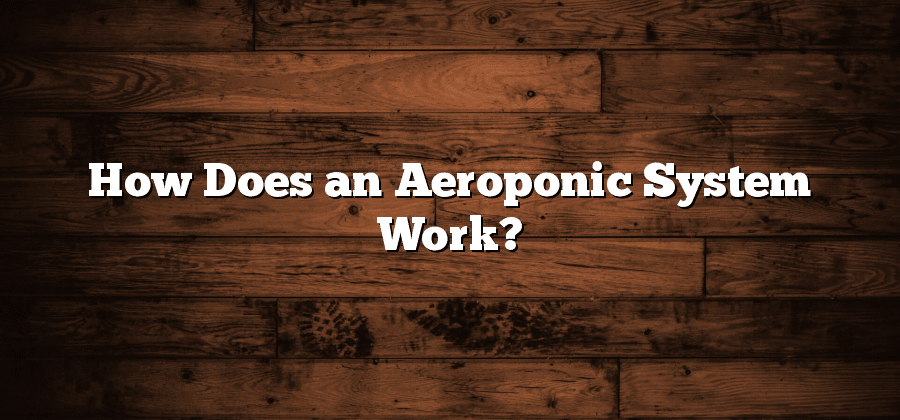I. Introduction to the System
Aeroponics is a modern and innovative system of growing plants that has gained significant popularity in recent years. Unlike traditional gardening methods that rely on soil, this system utilizes a nutrient-rich mist to nourish plant roots. In aeroponic systems, plants are suspended in air, allowing their roots to receive nutrients and oxygen in a highly efficient manner. This unique method of cultivation offers several advantages over conventional farming techniques, including improved nutrient absorption, faster growth rates, and the ability to grow a wide variety of crops in limited space.
One of the key factors that sets aeroponics apart from other growing methods is the use of nutrient solutions. These solutions are specially formulated to provide plants with the essential elements they need to thrive, such as nitrogen, phosphorus, and potassium. Unlike soil-based agriculture, where plants must extract nutrients from the soil, aeroponics delivers these nutrients directly to the roots through a fine mist. This precise delivery system ensures that plants receive an optimal balance of nutrients, resulting in healthier and more productive crops. Moreover, the use of nutrient solutions allows for greater control over the plant’s growth and development, as it is easier to adjust the nutrient composition to meet the specific requirements of different plant species.
2) The Role of Nutrient Solutions in Aeroponic Systems
One of the key components that plays a vital role in aeroponic systems is the nutrient solution. Unlike traditional soil-based methods, aeroponics relies on a nutrient-rich solution to provide plants with the essential elements they need to grow and thrive. This solution contains a balanced mix of nutrients, including nitrogen, phosphorus, potassium, and various micronutrients, which are dissolved in water.
The main function of the nutrient solution in aeroponics is to deliver these essential elements directly to the plant’s roots. Since the plants in an aeroponic system are suspended in air, their roots are exposed to the mist or spray of the nutrient solution. This direct contact allows the plants to absorb the nutrients more efficiently, resulting in faster growth rates and higher yields. Additionally, by providing a carefully balanced nutrient solution, aeroponic systems can ensure that plants receive the right amount of nutrients at the right time, optimizing their overall health and productivity.
3) Exploring the Importance of Oxygenation in Aeroponics
In the realm of aeroponic systems, one key factor that greatly influences the success of plant growth is oxygenation. Oxygen plays a vital role in plant development as it is essential for the process of respiration. In an aeroponic system, plants are suspended in a nutrient-rich mist, allowing the roots to access both air and nutrient solution. This unique setup provides an ample supply of oxygen to the roots, promoting healthier root growth and overall plant vigor.
The presence of oxygen in the root zone is crucial for various reasons. Firstly, oxygen is required for the uptake of nutrients by the roots. Without sufficient oxygen, the roots may become suffocated, leading to a decreased ability to absorb nutrients effectively. Additionally, oxygen-rich roots are less susceptible to diseases and pathogens, as many harmful organisms thrive in low-oxygen environments. Adequate oxygenation also improves nutrient absorption and utilization, ensuring that plants receive the necessary elements for optimal growth.
4) The Functionality of Mist Generators in Aeroponic Systems
Mist generators play a crucial role in ensuring the success of aeroponic systems. These devices are responsible for creating a fine mist, which is then sprayed directly onto the plant roots. The mist allows for maximum surface area contact, enabling the roots to absorb the necessary nutrients more efficiently. This method of nutrient delivery is incredibly effective, as it provides direct access to the plant’s root system. By utilizing mist generators, aeroponic systems can ensure that plants receive the essential nutrients they need to thrive.
One key advantage of mist generators in aeroponics is their ability to create a consistent and uniform mist. This consistency is important because it ensures that each plant receives an equal amount of nutrients, regardless of its position within the system. By evenly distributing the mist, mist generators help to prevent any potential nutrient deficiencies or imbalances. Additionally, the fine mist produced by these devices also helps to maintain optimal oxygen levels within the root zone, as it allows for continuous gas exchange. This oxygenation is vital for the health of the plant, as it supports key metabolic processes and maximizes nutrient absorption.
5) Nutrient Delivery: How Aeroponics Ensures Plant Nutrition
Aeroponics is a unique and innovative system of plant cultivation that offers numerous advantages over traditional farming methods. One crucial aspect of aeroponics is the efficient delivery of nutrients to the plants. Unlike soil-based systems, aeroponics eliminates the need for the plants to extract nutrients from the soil. Instead, a nutrient solution is directly sprayed onto the plant’s roots, ensuring optimal nutrient uptake.
In aeroponics, the nutrient solution plays a vital role in providing the necessary elements for plant growth and development. This solution is typically composed of water and a balanced mixture of essential nutrients in soluble form. These nutrients are carefully selected and formulated to meet the specific needs of each plant species. By delivering the nutrients directly to the roots as a fine mist, aeroponics maximizes the absorption efficiency and promotes rapid and healthy plant growth. This precise nutrient delivery system allows for better control over the nutrient levels, resulting in more precise and targeted nutrition for the plants.






